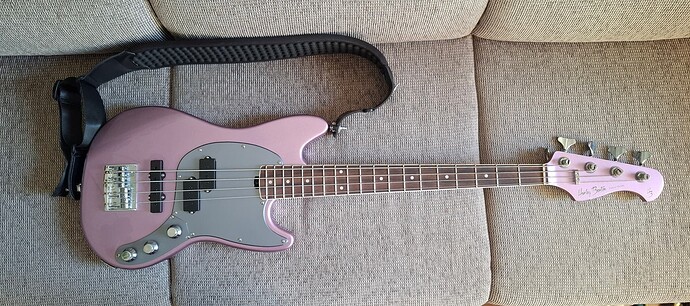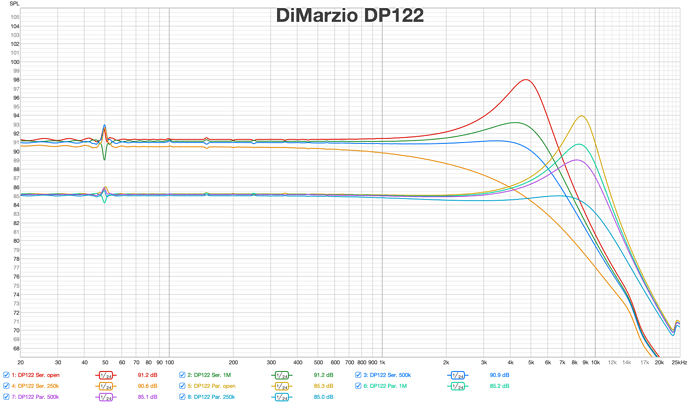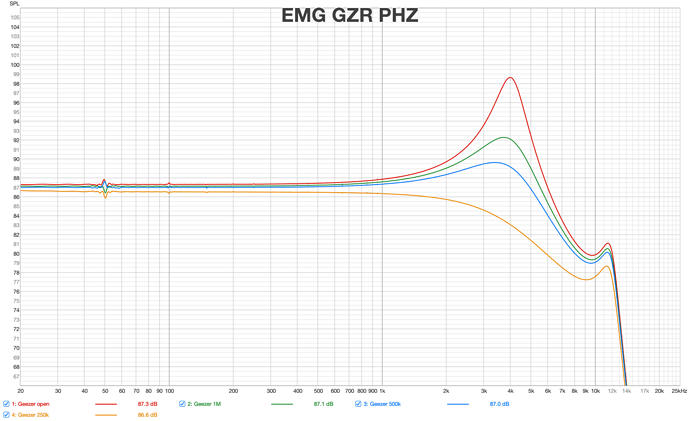That’s because you are in upside down land.
Says you wronglander!
Ha, no disagreement there.. I want to be back in the old world and preferably sooner rather than later..
Pink’s Hot is done!
Also, very happy - though sound-wise I do prefer Ronin (EMG GZR).
Pink’s Hot (DiMarzio) sounds very grown up and eloquent, but Ronin makes me feel like a little boy again.
Nobody wants to be grown up!!!
One thing I don’t like is the construction of the intonation setup on the Gotoh Gotoh 404BO bridge. As the screws go not through the saddles they need to be a +/- 2.5mm exact fit.
In my case (and in many other review I read on the internet), the screws are too long and need to be shortened. Same for the springs.
In my case I shortened 2.5mm, but it’s still not exactly right. I can’t hear intonation issues, but I’m sure that people like @Al1885 could.
Also, it is very hard to fiddle the screws into the bridge saddles, with potentially negative impact on the threads…
That’s an interesting take because in general the DiMarzio’s are more mids-focused and aggressive (and also hotter) than the EMG’s.
Yes, I read this many times in this thread. I wish that the Dimarzios were a little more aggressive.
I need to test if they are hotter. If they are, it is not significant.
I do need to fumble the volume pots all the time for every song, as most songs I play along to are not normalized (yet). But I did not get the impression that I needed to turn up the EMGs more or turn down the DiMarzios extensively…
Maybe I will make my next cover in a way that I switch between EMG GZR and DiMarzio? Just need to find a simple song that I can play and where there are breaks, so I can switch basses fast enough.
Question is: what configs? Tone on 0%?
And then
- P/J 100%
- P 0% / J 100%
- P 100% / J 0%?
I can already post a song with P 0% / J 0% ![]()
Are your pickup heights set the same for both sets?
No, currently they might be different at this moment. Pink’s Hot is setup perfectly, but I did not optimize Ronin yet - cause I changed the screws and am not sure if they are right.
The P pickups feel kind of loose on Ronin. I’m thinking about using threaded inserts, at least for the P pickups.
BUT: before yesterday they both were set to approx the same height (= distance to strings), and everything I say above still holds.
Again: I wish the Dimarzio would sound a little more aggressive. Love the sound, but Pink’s Hot was supposed to be my main bass, and Ronin sounds better (to me).
My test is: does the bass dominate the mix, even on my little in-ears? Ronin: YES!
I had such a big smile while playing Ronin in the park, that some of those beautiful single moms pulled away their children.
Must have been a little creepy ![]()
What is that a graph of? It is a frequency response graph of some kind but it is clearly not the pickup output as that is not at all what a P pickup response looks like, and it is too flat to be normalized to a reference P. It almost looks like the filter circuit response.
Google translate:
MEASUREMENT METHODS
The frequency responses are determined using a transmitter coil. Here, a very low-impedance coil with the measurement signal (noise or sweep/chirp) is controlled from a small power amplifier and placed above the pickup to be measured. The result must be recorded and provided with a 6dB/oct low pass to obtain the correct frequency response. I supply the transmitter coil via the headphone output of an RME ADI-2/4 Pro in 192kHz mode and use a measurement amplifier with 1MΩ||100pF input impedance as a buffer between the pickup and the converter. The free “REW” software is used to generate and evaluate the test signals.
Level measurements are not possible with this method because the strength of the magnets used is not taken into account; other methods are required. For reproducible results, I set the pickups to the same height (distances between polepiece and strings from E to G in mm: 8; 7.5; 7; 5) and deflected the E string to the edge of the fingerboard and the level generated measured with the oscilloscope.
The peak value is relevant for the correct control of recording equipment, amps, etc., as this is the highest signal level and is therefore crucial for distorting or not distorting input stages. An average effects pedal with a 9V supply voltage has, in the best case, a usable signal swing of approx. 4Vp or 8Vpp. If the signal from the pickup is higher than this, the circuit will inevitably distort.
The test instrument is a well-rehearsed Tokai Hard Puncher with a maple neck, fingerboard and ash body, strung with 105-045 steel strings. All tests were carried out with open controls for volume and tone.
In fact that looks exactly like a low pass filter response for a filter with high Q
Note on the graphics:
The additions 1M, 500k and 250k in the measurement data each stand for the added potentiometer values; the tone potentiometer has a 47nF capacitor soldered on. The addition “open” stands for measuring the pickup directly into a 1MΩ||100pF input of a preamplifier, such as that found in active electronics. It is therefore definitely worth trying out a pickup with different pot values or soldered directly to the socket in order to be able to exploit its full potential.
Green: 1M
Blue: 500k
Orange: 250k
Red: open
Level = peak voltage
Fres = resonance frequency
DCR = DC resistance
Ser/Par = Serial or Parallel
Service for nerds:
If you want to take a closer look, you can download the original measured values HERE (https://www.gitarrebass.de/wp-content/uploads/2024/03/Split-Coil-Frequenzgang-Messwerte.zip) and open them in the Room EQ Wizard software (File → Import → Frequency response → Select files → open by double-clicking).
Yes that is measuring the effect of the filter on the pickup, not the pickup output
I cannot judge it, but I can say that Gitarre&Bass is a very well respected publication (est 1986) and Joris Henke is an expert in his field…
I am saying they are not measuring what you think they are, not that they are wrong. Also google “Appeal to Authority Fallacy” please ![]()
But … but … but YOU are my authority ![]()
What they are measuring is the response of the entire circuit - filter, volume pot, and pickup coil - as you sweep a reference signal through it. While this is very interesting and is indicative of some tonal properties, it is not a measure of overall pickup output across the range, which will be strongly influenced by the magnet as well.
Ok, so from the graphs we cannot gather the tonal character of the PUs?
Not entirely but you can learn a lot. The more the signal deviates from a perfect filter shape the more “character” it would have. I am used to raw response graphs so I would need to read how to interpret this more.


